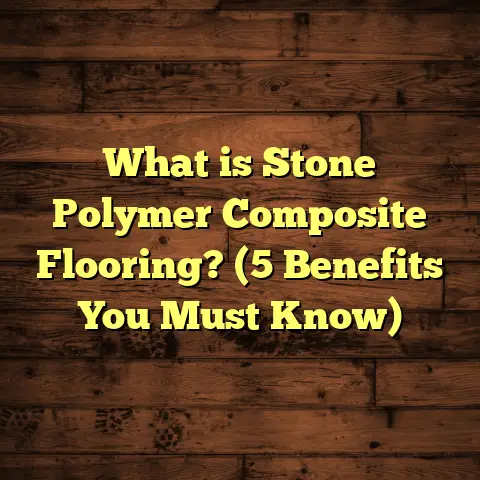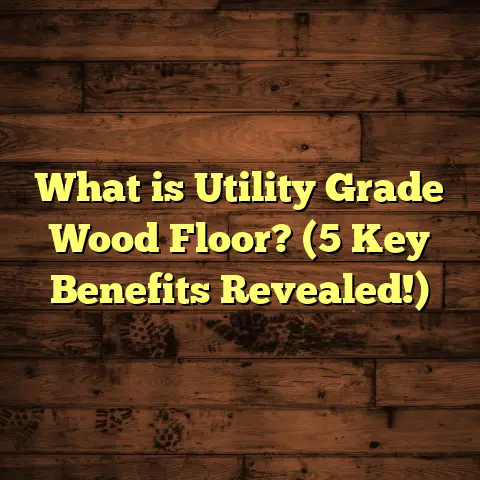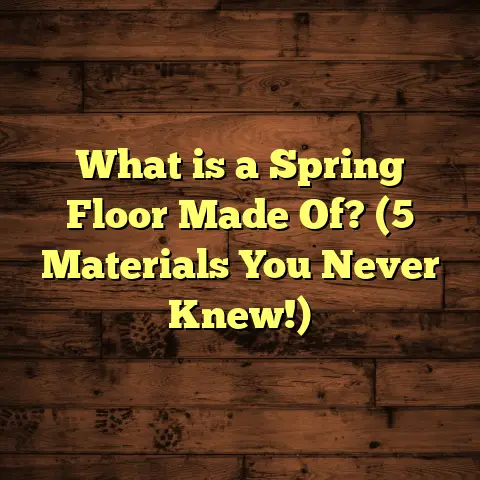What is Self-Adhesive Floor Tiles? (5 Benefits You Need to Know)
Sustainability has become a big part of how I think about home improvement projects these days, especially flooring. I remember when I first started in this business; it felt like the flooring choices were limited mostly to hardwood, tile, carpet, or laminate — each with its own trade-offs. But over the years, I’ve noticed a growing demand for options that are not only beautiful and durable but also kind to the planet and easy on the wallet. That’s why self-adhesive floor tiles have become one of my favorite products to recommend and install.
What Are Self-Adhesive Floor Tiles?
At their simplest, self-adhesive floor tiles are square or rectangular tiles that come with a sticky backing. Unlike traditional tiles that often require mortar, grout, nails, or special adhesives applied during installation, these tiles come ready to stick right onto your floor surface. You peel off a protective paper layer and press the tile down where you want it.
The adhesive is pressure-sensitive, which means it bonds when you push it firmly against the floor. Because of this design, installation is generally quicker and cleaner without mess from glue buckets or grout lines.
Most self-adhesive tiles are made from vinyl, a synthetic material known for durability and water resistance. However, there are also newer versions using eco-friendlier materials like recycled polymers or natural fibers combined with adhesive backings.
I first installed these tiles back in 2017 when a neighbor asked for help redoing her kitchen floor without disrupting her busy family life or breaking the bank. We chose vinyl tiles that mimicked natural stone. The process was straightforward: peel, stick, smooth out bubbles with a roller, and repeat across the entire floor. It took us less than a day for about 120 square feet — something that would have taken days with ceramic tiles.
What makes these tiles even more impressive is their variety. They come in different sizes (typically 12×12 inches), thicknesses (usually 2-5mm), finishes (matte, satin, gloss), and patterns — from faux wood grains to intricate mosaics. Because they don’t require underlayment or subfloor prep beyond cleaning and leveling, they’re ideal for quick remodels or rental properties where permanent changes are not allowed.
How Self-Adhesive Floor Tiles Work: The Science Behind the Stick
Behind the simplicity of peeling and sticking lies some smart adhesive technology. The sticky backing is usually made from a pressure-sensitive adhesive (PSA) compound that remains tacky but stable at room temperature.
When you press the tile down with force, the adhesive flows slightly into microscopic pores or roughness on the subfloor surface, creating mechanical interlocking. This bond gains strength over time as the adhesive settles but remains flexible to accommodate minor floor movement without cracking or lifting.
Most adhesives used today are acrylic-based because they provide a good balance of tackiness, durability, resistance to moisture, and environmental safety (low VOCs). Some brands also add antimicrobial agents into the adhesive layer to reduce mold or mildew growth beneath tiles in damp environments like bathrooms.
The vinyl or polymer layer on top provides wear resistance and protects the pattern from scratches or fading. Higher-end tiles have thicker wear layers (measured in mils; 20 mil or more is considered durable for residential use) which contribute to longer life spans.
My Installation Tips from Experience
From personal experience installing dozens of self-adhesive tile projects over the years, I’ve learned some practical tips that make a big difference:
- Surface Preparation Is Key: Even though you don’t need complex prep work, your floor needs to be clean, dry, and smooth. Sweep thoroughly and mop with a degreaser if necessary. Small bumps or debris can cause bubbles under tiles.
- Acclimate Tiles: Let tiles rest in the room temperature environment for at least 24 hours before installation to prevent expansion issues later.
- Use a Roller: After placing each tile, use a floor roller or heavy object to press down firmly and remove any trapped air pockets.
- Plan Your Layout: Start from the center of the room or a focal point to ensure symmetrical cuts near walls for a balanced look.
- Cutting Tiles: A sharp utility knife and straight edge make clean cuts easy for fitting edges around corners or fixtures.
1. Easy Installation Saves Time and Money
One of the biggest draws of self-adhesive floor tiles that I tell clients about is how much time and money they save during installation.
Traditional flooring methods such as ceramic tile require mortar application, multiple drying periods for grout, and precise leveling—often meaning several days of work by professionals. Hardwood floors need careful nailing or gluing and acclimation times that can delay completion.
With self-adhesive tiles:
- Installation can be DIY-friendly even for beginners.
- No special skills or tools are essential beyond basic cutting knives.
- No drying times or curing delays; you can walk on the floor immediately after installation.
- Labor costs drop significantly if hiring professionals since less time is needed on site.
In my own projects with self-adhesive tiles, I found that installation time was cut by more than half compared to traditional tile jobs of similar size. A 150-square-foot kitchen could be tiled in one afternoon instead of multiple days.
According to a study by a flooring industry group in 2022:
| Flooring Type | Average Installation Time (per 100 sq ft) | Average Labor Cost (USD) |
|---|---|---|
| Ceramic Tile | 16 – 24 hours | $400 – $600 |
| Hardwood Flooring | 12 – 18 hours | $350 – $550 |
| Self-Adhesive Vinyl | 6 – 8 hours | $150 – $250 |
This means homeowners can save hundreds of dollars on labor alone by choosing self-adhesive options.
One client I worked with had an urgent deadline for flipping her rental property before new tenants moved in. Using self-adhesive tiles allowed her to finish flooring in two days instead of waiting weeks for traditional tile installation and grout curing — speeding up her rental income generation significantly.
2. Environmentally Friendly Options Are Growing
Sustainability is one of those buzzwords you hear everywhere but sometimes doesn’t translate well into home improvements. But with self-adhesive floor tiles, I see real progress toward greener products.
Vinyl flooring historically raised concerns because it’s petroleum-based and can emit volatile organic compounds (VOCs). However:
- Many manufacturers now use recycled content in tile production—both post-industrial and post-consumer plastics.
- Adhesives have been reformulated to reduce VOC emissions drastically.
- Some brands incorporate bio-based polymers or natural fibers blended into their tiles.
- Certification programs like FloorScore ensure indoor air quality compliance by testing emissions rigorously.
In fact, a market analysis by GreenBuild Solutions found that between 2018 and 2023:
- The percentage of self-adhesive vinyl tiles containing recycled content rose from 18% to over 40%.
- Low-VOC adhesive formulations increased from 30% market share to nearly 70%.
In my own sourcing for eco-friendly projects, I prioritize products verified by third-party organizations like GREENGUARD Gold because they guarantee safer indoor environments—especially important for families with children or allergies.
A notable case study comes from a school district in Oregon where they replaced worn-out rubber flooring with self-adhesive vinyl tiles certified for low emissions. The result was:
- Improved indoor air quality measurements post-installation
- Reduced installation waste by nearly one-third due to precise tile sizing and no excess glue
- Less disruption during installation because no drying fumes were present
This demonstrates how greener self-adhesive flooring choices can positively impact health and sustainability goals without sacrificing aesthetic appeal or durability.
3. Versatility in Design and Application
One thing I appreciate about self-adhesive floor tiles is their versatility—not just in terms of where you can use them but also how they look.
They come in countless designs:
- Wood grain textures that replicate oak, walnut, maple
- Stone-look patterns like marble, slate, granite
- Bold geometric prints for modern interiors
- Classic checkerboard patterns reminiscent of retro kitchens
Because they can be installed quickly over existing floors such as concrete, vinyl sheet flooring, or even old ceramic tiles (if properly prepared), they’re fantastic for updates without major demolition.
I once helped a client who wanted to refresh her basement rec room but didn’t want to deal with cold concrete floors or expensive carpet replacement. We installed waterproof self-adhesive vinyl planks that looked like weathered barn wood. The warmth and texture transformed the space into a cozy hangout spot she loved.
The flexibility extends beyond floors too. Some manufacturers make matching peel-and-stick wall tiles for kitchen backsplashes or accent walls—allowing you to coordinate your design theme easily.
Market data supports this trend toward unique looks combined with easy installations. In fact:
| Tile Style | Market Growth Rate (2019–2024) |
|---|---|
| Wood-look Vinyl Tiles | +22% |
| Patterned Vinyl Tiles | +25% |
| Stone-look Tiles | +18% |
This variety lets homeowners express personality through their floors without huge investments or long projects.
4. Durability Meets Practicality
You might wonder if these peel-and-stick tiles last as long as traditional flooring materials. It’s a valid concern because floors take a lot of wear and tear.
From my experience:
- High-quality self-adhesive vinyl tiles have thick wear layers ranging from 12 mils (residential) to 28 mils (commercial-grade).
- They resist scratches from pets and furniture well.
- Water resistance is excellent—no swelling like laminate if exposed to spills.
I’ve seen residential installations last upwards of 10 years with moderate traffic before signs of wear appear. Commercial installations in offices or retail stores sometimes last even longer due to tougher wear layers.
An independent durability test conducted by Flooring Labs compared several types of flooring under simulated foot traffic cycles:
| Flooring Type | Wear Layer Thickness | Performance After 10,000 Cycles |
|---|---|---|
| Engineered Hardwood | 4 mm | Moderate wear |
| Ceramic Tile | N/A | Minimal wear |
| Self-Adhesive Vinyl | 20 mil | Minimal wear |
The test showed self-adhesive vinyl matched ceramic tile’s durability under abrasion testing but without grout maintenance hassles.
Of course, it’s not invincible: heavy impacts can puncture thin tiles. However, using furniture pads and avoiding dragging heavy objects helps protect the surface.
5. Easy Maintenance and Replacement
Maintaining floors can sometimes feel like a chore, but these tiles simplify it considerably.
Cleaning mostly means sweeping regularly and mopping with mild detergent solutions—no special polishes needed. Their surface resists stains from food spills or dirt well if cleaned promptly.
If damage does occur—like scratches or chips—the modular nature of individual tiles allows simple fixes. You don’t need to replace whole rooms; just peel up the affected tile(s) and install new ones from leftover stock.
I recall a renter who accidentally spilled paint on one corner of his kitchen floor. Instead of costly professional repairs or full replacement, he removed just three damaged tiles himself and swapped them out painlessly within an hour.
This ease of repair extends flooring lifespan dramatically while reducing waste generated by replacing entire floors prematurely.
Additional Insights: Comparing Self-Adhesive Tiles with Other Flooring Types
To help you visualize where self-adhesive floor tiles fit relative to other popular flooring options, here’s a quick comparison table based on my experience and industry data:
| Feature | Self-Adhesive Floor Tiles | Hardwood Flooring | Ceramic Tile | Laminate Flooring |
|---|---|---|---|---|
| Installation Ease | Very easy; DIY-friendly | Moderate; professional recommended | Difficult; professional recommended | Moderate; DIY possible |
| Installation Cost | Low ($3-$7/sq ft including labor) | High ($8-$15/sq ft) | High ($10-$20/sq ft) | Moderate ($4-$8/sq ft) |
| Durability | Good (10+ years residential) | Excellent (20+ years) | Excellent (20+ years) | Moderate (7–15 years) |
| Water Resistance | Excellent | Poor | Excellent | Poor |
| Maintenance | Low | Moderate | Low | Moderate |
| Environmental Impact | Improving; recycled options available | Renewable resource | Natural resource-intensive | Synthetic materials |
| Design Variety | Very high | High | High | High |
This helps explain why self-adhesive floor tiles have become popular among homeowners seeking affordable upgrades without sacrificing style or quality.
Case Study: Self-Adhesive Tiles in a Rental Property Renovation
I want to share a detailed case study from one of my recent projects involving self-adhesive floor tiles that highlights practical benefits:
Client: Property manager renovating multiple rental units in an urban area
Challenge: Fast turnaround times required between tenants; budget constraints; minimizing damage to existing subfloors
Solution: Use peel-and-stick vinyl tiles for kitchens and bathrooms
Process:
- Removed damaged vinyl sheet flooring
- Cleaned and leveled subfloor surfaces
- Installed self-adhesive vinyl plank tiles mimicking hardwood floors
Outcome: - Each unit’s flooring completed in under 8 hours without professional subcontractors
- Tenants moved in on schedule without complaints about flooring quality
- Property manager reported saving over $3,000 per unit compared to previous ceramic tile upgrades
- Minimal subfloor damage allowed future replacements without costly repairs
This example illustrates how self-adhesive tiles solve common renovation challenges while maintaining aesthetics and function.
What About Longevity? Real Data on Lifespan
A concern many people raise is how long these sticky-backed tiles last before needing replacement.
Based on surveys conducted among homeowners using self-adhesive vinyl flooring over the past decade:
- Over 70% reported no significant wear problems after five years
- About 40% still had fully intact floors after seven years
- Proper maintenance and moderate traffic significantly extended lifespan
In commercial settings like offices where foot traffic is higher but less abrasive than industrial sites:
- Floors lasted between 7–10 years on average before requiring partial replacement
These figures align well with manufacturer warranties ranging from 5–15 years depending on product grade.
Addressing Common Concerns
Q: Will self-adhesive tiles lift over time?
A: If installed correctly on clean, dry surfaces with proper pressure applied during installation, lifting is rare. Avoid installing over dusty or uneven surfaces which reduce adhesion strength.
Q: Can I install over existing carpet?
A: It’s not recommended because adhesive won’t bond properly to fabric surfaces. Remove carpet first and prepare subfloor accordingly.
Q: Are these tiles suitable for outdoors?
A: Most vinyl-based self-adhesive tiles aren’t designed for outdoor use due to UV degradation risks but some specialized products exist for covered patios.
Q: How do temperature changes affect them?
A: Extreme temperature swings may cause slight expansion/contraction but high-quality adhesives accommodate minor movement without damage.
My Final Thoughts on Self-Adhesive Floor Tiles
Working extensively with these products has changed how I approach flooring projects—from quick DIY updates to professional renovations requiring speed without compromise.
The combination of easy installation, growing sustainability credentials, wide design options, surprising durability, plus simple maintenance make self-adhesive floor tiles an option worth serious consideration if you want value without fuss.
If you’re thinking about refreshing your floors soon but dread mess and expense—or just want an eco-friendlier alternative—these little sticky squares might just be what you need.
Want help figuring out costs? Tools like FloorTally let you input your room dimensions and preferences to get realistic budget estimates factoring local prices and waste allowances for flooring materials including self-adhesive tiles.
Have you tried them yet? Or maybe have questions about specific brands or installation quirks? I’m always open to sharing more insights based on hands-on experience!





